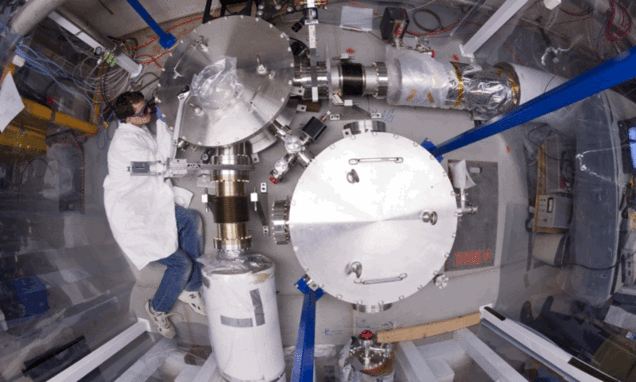
The Holographic Principle
The three-dimensional world we see around us now emerges from information contained in a two-dimensional space. This is the Holographic Principle, albeit in very simple terms.
Notably, it does not assert that we live in a Star Trek-like holodec, the Matrix, or anything similar. Rather, it posits that what we perceive as three dimensional may just be the image of two dimensional processes on a huge cosmic horizon. It is remarkable theoretical work, and an interesting way of interpreting the fundamental physics of our universe. In essence, this principle helps physicists reconcile string theory with Einstein’s theory of relativity, becoming one of the most influential ideas in theoretical physics.
For a detailed discussion, see our previous coverage.
Since the time that it emerged as a prominent theory, we have developed a way to test these ideas, at least to a certain degree. Case in point, scientists from Fermilab have developed what they call “the Holometer,” a $2.5 million experiment using an apparatus designed to measure the the smoothness of spacetime down to the thousandth of a proton, as a means of testing the “untestable” Holographic Principle.
After years of experiments, Fermilab found no evidence to support the Holographic Principle, but Craig Hogan, a professor from the University of Chicago and head of the Fermilab Center for Particle Astrophysics, says that this null result does not disprove the holographic principle.
And notably, a number of scientists have spoken out questioning the validity of the test, saying that there is no way it could prove, disprove, or really give us any evidence of anything at all. In short, the whole test is an enormous waste of time and money.
Though the Holometer experiment at Fermilab just published the results of their search for holographic space-time foam and didn’t find any evidence for noise that could be indicative of quantum gravity, physicist Sabine Hossenfelder notes that those who understood the experiment didn’t really expect anything different, as this particular test wasn’t based on viable models of the Holographic Principle. In short, it would have violated other known aspects of our universe.
She writes, “I sincerely hope that Fermilab won’t pump any more money into this unless the idea goes through rigorous peer review. It isn’t just annoying. It’s a slap into the face of many hard-working physicists whose proposals for experiments are of much higher quality but who don’t get funding.
At the very least, if you have a model for what you test, you can rule out the model. With the Holometer you can’t even rule out anything because there is no theory and no model that would be tested with it. So what we have learned is nothing. I can only hope that at least this episode draws some attention to the necessity of having at mathematically consistent model. It’s not an easy job. But it has to be done.” (for more on this test, please see her full write-up on it.)
A Valuable New Tool
Astrophysicist Brian Koberlein explains the principle saying “Just to be clear, there’s no observational evidence that the universe is a hologram…but there is some interesting theoretical work regarding the holographic principle that is worth discussing.” See this linked post for more on the topic from him.
Hogan says that the Holometer is able to reach the sensitivity they aimed for, which shows that the method has potential in making further measurements. “For me, the big news is that we have a technique for measuring spacetime at this level,” adds Hogan. Other scientists, however, assert that the “big news” is really just bunk.